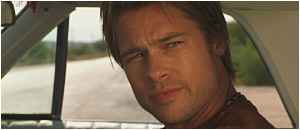 On their own, Brad Pitt and Julia Roberts maintain considerable box office clout. Actually, Julia clearly is the more consistent draw; the last time she made a film that grossed less than $100 million was 1998’s Stepmom, and even that flick took in a fairly respectable $91 million.
On their own, Brad Pitt and Julia Roberts maintain considerable box office clout. Actually, Julia clearly is the more consistent draw; the last time she made a film that grossed less than $100 million was 1998’s Stepmom, and even that flick took in a fairly respectable $91 million.
Pitt, on the other hand, hasn’t made a top-grossing movie in years. Recent efforts like Snatch and Fight Club have been high profile films, but they’ve not exactly fired up the US box office. You have to go back to 1995’s Se7en to find a Pitt product that really could be regarded as a hit, and it remains one of only two Pitt movies to top the $100 million mark. Both Se7en and 1994’s Interview With the Vampire just barely made it past that figure.
Granted, success is relative, which is why a gross of $190 million for Pearl Harbor seems to be somewhat lackluster while the $140 million take of The Blair Witch Project remains phenomenal. Nonetheless, I must admit it’s confusing to figure why Pitt’s considered such a huge star. His movies don’t do much business, yet he’s regarded as one of the most popular male actors. To his credit, however, I have to acknowledge that his film selection clearly has influenced this. More so than most other “A”-list actors, Pitt is willing to choose offbeat flicks such as Snatch. Rather than go the hunky heroic route he established in Legends of the Fall, Pitt’s fashioned a rather eclectic career. Would he have maintained consistently higher grosses had he chosen more safely? Probably, though that will have to remain an unknown.
Based on the career of Roberts, that last sentiment seems more likely, for she really does tend to take the path of least resistance. Roberts’ two initial hits were 1989’s Steel Magnolias and 1990’s Pretty Woman, and those films seemed to set her on her specific course, for she’s usually stuck to somewhat similar efforts. Roberts prefers to go for either light romantic comedies such as Notting Hill and Runaway Bride or estrogen-friendly dramas like Erin Brockovich and the aforementioned Stepmom. Occasionally an exception slips in, but as a whole, this sums up her oeuvre pretty neatly.
 The disparity between their drawing powers seems to be great. To date, Roberts’ movies have taken in a total of more than one and a half billion dollars, which makes her arguably the most successful actress of all-time. On the other hand, Pitt languishes at 62nd on the list of top male actors, and his movies have reaped only half of that amount. (For the record, the chart I used showed 19 flicks for Roberts and 18 for Pitt, so it was pretty equal.)
The disparity between their drawing powers seems to be great. To date, Roberts’ movies have taken in a total of more than one and a half billion dollars, which makes her arguably the most successful actress of all-time. On the other hand, Pitt languishes at 62nd on the list of top male actors, and his movies have reaped only half of that amount. (For the record, the chart I used showed 19 flicks for Roberts and 18 for Pitt, so it was pretty equal.)
As an aside, I was somewhat stunned to see how far the top women lag behind the most successful men. Eleven males have totals greater than that of Roberts, although it should be noted that all of them have also made more movies. Still, it was a bit surprising to see such a differential.
It was also weird to note that Pitt got top billing over Roberts for The Mexican. Perhaps this would have been different had the film hit screens after her Oscar victory, but I doubt it. By the way, although another website stupidly asserts that Julia’s Oscar acceptance speech negatively affected grosses of The Mexican, this is completely incorrect. The film reached theaters on March 2 2001, while the ceremony didn’t take place until March 25 2001. By that point, The Mexican was essentially spent as a box office force in the US, so Roberts’ Academy Awards demeanor clearly didn’t do anything to alter that films’ success.
Speaking of which, The Mexican is regarded by virtually everyone as a bit of a box office dud since it only grossed $66 million in the US. That isn’t an atrocious total per se, but when one factors the golden glow of BRAD and JULIA into the equation, it does look pretty weak. Interestingly, The Mexican was originally intended to be a fairly low-budget piece without such notable names behind it, but apparently it attracted their attention and thus became a major release.
 Frankly, I think The Mexican would have fared better without Roberts and Pitt. I feel this way for a number of reasons, but mostly because their presence created this mega-expectation that the film was unlikely to deliver. The Mexican was an edgy “R”-rated flick that didn’t fall within the dimensions of a probable crowd-pleaser. Sure, some fare of this sort can reach a major audience; for example, Pulp Fiction comes to mind. However, that was an unusual flick that became a cultural phenomenon; for a film such as The Mexican, a $66 million gross is actually quite good, but it still couldn’t match the expectations created by this first-ever pairing of two Hollywood icons.
Frankly, I think The Mexican would have fared better without Roberts and Pitt. I feel this way for a number of reasons, but mostly because their presence created this mega-expectation that the film was unlikely to deliver. The Mexican was an edgy “R”-rated flick that didn’t fall within the dimensions of a probable crowd-pleaser. Sure, some fare of this sort can reach a major audience; for example, Pulp Fiction comes to mind. However, that was an unusual flick that became a cultural phenomenon; for a film such as The Mexican, a $66 million gross is actually quite good, but it still couldn’t match the expectations created by this first-ever pairing of two Hollywood icons.
I also believe The Mexican would have been a superior movie without Roberts and/or Pitt just because I don’t think they were right for the roles. As Jerry, Pitt needed to create a “loveable loser” aura, and I felt that he retained too much of his innate charisma for it to work. I’m a big fan of Pitt’s work, and he can distance himself from his good looks at times; for example, I never felt like he seemed to be too attractive for his role in Se7en. However, Pitt simply appeared to be too gorgeous during The Mexican. Something about him kept up that golden glow that made Jerry come across as too strong and alluring for the character’s good.
On the other hand, Roberts looked surprisingly unattractive as Samantha. Not that she presented an ugly image, but I thought she came across as pasty and blotchy. However, this made more sense for the character, so my comments aren’t a complaint; Roberts’ Samantha didn’t seem to be sexy enough for a hunk like Pitt’s Jerry, but that’s neither here nor there.
Nonetheless, I thought that Roberts came across as excessively unappealing in the role due to the personality traits she adopted. While I’m not much of a fan of Roberts’ work, I can’t deny that she is able to turn on the charm when necessary. Unfortunately, that never happens during The Mexican. She consistently seems like a fairly unpleasant person, and it feels difficult to understand why Jerry loves her so much, especially since a stud like him should be able to land any number of other babes. Granted, the movie’s theme line revolves around the notion that we don’t actually choose who we love, but we should at least see some reason for the connection between these two.
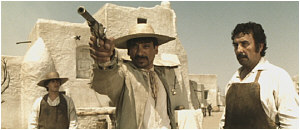 Most people appear to feel that the real star of The Mexican was James Gandolfini, best known for his work on The Sopranos. I have to agree with this notion, as Gandolfini did provide fine work in the role of gay hit man Leroy. His accent seemed cartoonish, but he still added a level of believability, charm, and warmth to his character that was absent from most of the others. Gandolfini and Roberts actually displayed a pretty fine chemistry, and their scenes together - which encompass virtually all of Gandolfini’s work in the film - were the best parts of the movie.
Most people appear to feel that the real star of The Mexican was James Gandolfini, best known for his work on The Sopranos. I have to agree with this notion, as Gandolfini did provide fine work in the role of gay hit man Leroy. His accent seemed cartoonish, but he still added a level of believability, charm, and warmth to his character that was absent from most of the others. Gandolfini and Roberts actually displayed a pretty fine chemistry, and their scenes together - which encompass virtually all of Gandolfini’s work in the film - were the best parts of the movie.
Another problem with the Julia/Brad pairing stemmed from the fact that they barely spent any time on-screen together. This wasn’t the fault of the script or the director or anyone, really; as I noted, the movie was never intended to be a star vehicle for either of them. While I admire the fact that all involved resisted the temptation to alter the story to pair up Roberts and Pitt more frequently, it did make the movie feel like a tease. For better or for worse, many people were attracted to The Mexican due to the combination of its stars. The fact it had them interact so infrequently couldn’t help but make the film seem like a piece of false advertising, and it did make me wonder what the point of their inclusion was; why bother to bring in two of the world’s biggest stars if you won’t have them work together?
Overall, The Mexican felt like a somewhat disjointed piece, and it suffered from Tarantino-wannabe syndrome. It was one of those dark, violent semi-comedies that tried hard to be hip and fresh but it mainly just seemed like another in a line of many pretenders. The Mexican was a watchable piece, but it lacked much flair or anything compelling to make it a better film.
The DVD:
 The Mexican appears in an aspect ratio of approximately 2.35:1 on this single-sided, dual-layered DVD; the image has been enhanced for 16X9 televisions. Although the picture betrayed a few concerns, as a whole it offered a very strong visual experience.
The Mexican appears in an aspect ratio of approximately 2.35:1 on this single-sided, dual-layered DVD; the image has been enhanced for 16X9 televisions. Although the picture betrayed a few concerns, as a whole it offered a very strong visual experience.
Sharpness consistently looked crisp and well-defined. At no point during the film did I witness any examples of soft or fuzzy images. However, I did see some examples of moiré effects, and a little edge enhancement appeared to be present as well. Print flaws were very minor. The picture betrayed a little light grain and a few specks, but otherwise it seemed to be clean and fresh.
The Mexican offered a rather stylized palette, and the tones varied depending on the location. For Mexico, the image took on a slightly brownish tint, while the Las Vegas scenes usually displayed a minor greenish look. Neither was excessive, but they existed nonetheless. Overall, the colors appeared to be clear and accurate within those constraints. I always felt that the DVD represented them well and the hues were quite solid.
Black levels also seemed to be nicely deep and dense, and shadow detail usually came across as appropriately heavy but not overly thick. At least one shot of Pitt looked a little dark, but otherwise the movie presented good definition in low-light sequences. While the image of The Mexican didn’t quite reach “reference” levels, it still offered a fine presentation as a whole.
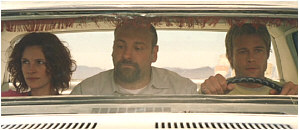 While I liked the picture of The Mexican, I have to acknowledge I maintained stronger feelings about its soundtracks. The DVD included both Dolby Digital 5.1 and DTS 5.1 mixes, and I truly loved both of them, though in this instance, I have to give the nod to the DTS version. Quite a few recent DVDs have provided both DTS and DD sound, and I rarely discern much of a difference between them. However, in this case, I definitely preferred the DTS track. For this review, I’ll discuss the Dolby Digital mix initially, and I’ll cover the improvements heard in the DTS track during a subsequent paragraph.
While I liked the picture of The Mexican, I have to acknowledge I maintained stronger feelings about its soundtracks. The DVD included both Dolby Digital 5.1 and DTS 5.1 mixes, and I truly loved both of them, though in this instance, I have to give the nod to the DTS version. Quite a few recent DVDs have provided both DTS and DD sound, and I rarely discern much of a difference between them. However, in this case, I definitely preferred the DTS track. For this review, I’ll discuss the Dolby Digital mix initially, and I’ll cover the improvements heard in the DTS track during a subsequent paragraph.
Although it wasn’t the sort of film from which you’d expect a five-channel extravaganza, The Mexican presented a fairly active soundfield. The forward spectrum dominated the proceedings, but not to the level one might think. In that domain, sounds seemed to be accurately placed, and they blended together cleanly and neatly. Localization was very good, as even speech often appeared within a logical space. As such, the forward channels provided strong delineation of dialogue, music and effects that created a realistic setting.
The surrounds also added quite a lot of material. They consistently supplied good reinforcement of music and general ambience, but they often did more than that. During quite a few scenes, the rear channels contributed clear and distinct elements, and they really gave the track a great deal of life. For example, the fireworks scene in Mexico showed fine split surround usage as it created a natural and convincing situation. Ultimately I was surprisingly impressed by the soundfield featured during The Mexican.
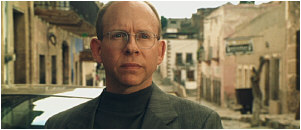 Audio quality also seemed to be strong. Dialogue always sounded natural and distinct, as I discerned no concerns related to edginess or intelligibility. Music was clear and robust. The score appeared to be vivid and dynamic, and it showed very natural and warm tones throughout the film. Best of all were the effects, which boasted some tight and deep bass. These elements came across as quite dynamic, and they often packed a significant punch. As such, The Mexican offered a very solid sonic
Audio quality also seemed to be strong. Dialogue always sounded natural and distinct, as I discerned no concerns related to edginess or intelligibility. Music was clear and robust. The score appeared to be vivid and dynamic, and it showed very natural and warm tones throughout the film. Best of all were the effects, which boasted some tight and deep bass. These elements came across as quite dynamic, and they often packed a significant punch. As such, The Mexican offered a very solid sonic
So how did the DTS mix improve upon the Dolby Digital track? In general, it simply sounded bolder and warmer, and it also created a more seamless environment. Placement of elements appeared to be less “speaker-specific” during the DTS edition, and the sounds meshed together better. As such, the entire package came across as more enveloping and engrossing.
Dynamic range also appeared to be stronger. Highs were a little clearer, and bass response seemed to be noticeably deeper and tighter. I found the low-end to be positively stunning during some parts of The Mexican; even dialogue periodically showed more depth than I usually encounter. While the Dolby Digital mix of The Mexican worked well in its own right, I thought it paled by comparison with the pleasures of the DTS track; I was so enamored of the latter that I nearly gave it an “A+” for audio, but I restrained myself and stuck with a simple “A”.
On this special edition DVD, we find a reasonably solid batch of supplements. First up is a running audio commentary from director Gore Verbinski, writer J.H. Wyman and editor Craig Wood. All three were recorded together for this screen-specific affair. Overall, I thought this was a decent track, but it lacked enough spark and consistently interesting material to make it special.
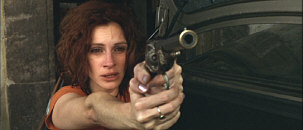 To say the least, this was a low-key presentation, as all three men maintained a fairly quiet and subdued demeanor throughout the track. That’s not necessarily a bad thing, but it led to a few too many empty gaps, and at times, they seemed to have trouble coming up with material. At one point, Verbinski even pointed out that he’s never been able to sit through an entire audio commentary, and he appeared to think that the whole enterprise was a bit of a waste of time.
To say the least, this was a low-key presentation, as all three men maintained a fairly quiet and subdued demeanor throughout the track. That’s not necessarily a bad thing, but it led to a few too many empty gaps, and at times, they seemed to have trouble coming up with material. At one point, Verbinski even pointed out that he’s never been able to sit through an entire audio commentary, and he appeared to think that the whole enterprise was a bit of a waste of time.
However, there was enough solid information to make this track generally useful. In addition to some good production notes and anecdotes from the set, the participants added very incisive interpretation of the story and the characters. These helped flesh out the movie, and they ultimately made the commentary worthwhile. It remained a spotty and inconsistent track, but fans of the film should get good details out of it.
The Making of The Mexican clearly falls into the “promotional piece of fluff” category. At 14 minutes and 55 seconds, it runs long enough to potentially provide some detailed information, but it almost entirely avoids those possibilities. Instead, we hear the usual plot synopsis and a discussion of how great everyone and everything is. The program mixes many clips from the film with shots from the set and interviews with the principals. Although it isn’t an unenjoyable piece, it lacks any substance and it reveals very little useful information about the film’s creation.
In addition, the DVD tosses in eight Deleted Scenes. These last between one minute, 33 seconds and four minutes, 32 seconds for a total of 22 minutes, 45 seconds of material. Some fell under the heading of extended sequences, but most actually were completely removed from the film. Most dealt with character issues; for example, we see an entire excised subplot about Ted and the pawnshop owner. None of the deleted stuff was great, but I thought some of it was fairly interesting.
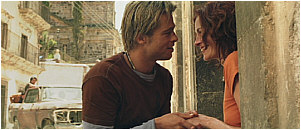 The “Deleted Scenes” can be viewed with or without commentary from Verbinski, Wyman and Wood. They maintained the same subdued demeanor heard during the main track, but I thought they got the job done here. They discussed the reasons for the omissions, and they added some new production information that was reasonably interesting. All I ask of deleted scenes commentaries is that they tell me why the clips were cut; this one did so, and it did so nicely.
The “Deleted Scenes” can be viewed with or without commentary from Verbinski, Wyman and Wood. They maintained the same subdued demeanor heard during the main track, but I thought they got the job done here. They discussed the reasons for the omissions, and they added some new production information that was reasonably interesting. All I ask of deleted scenes commentaries is that they tell me why the clips were cut; this one did so, and it did so nicely.
A few more standard features round out the DVD. We find both the film’s theatrical teaser and its trailer plus some fairly detailed text Production Notes; an abbreviated version of the latter also appears in the DVD’s booklet. Additional text can be found in the “Cast” and “Crew” sections. The entries themselves are pretty good but not great. However, as was the case with past DreamWorks DVDs like Saving Private Ryan and Galaxy Quest, the listings for The Mexican slay with sheer numbers; we learn details about 10 actors and 13 crewmembers. Since the biographies really are fairly good for this kind of feature, that makes these some of the best in the business.
I can’t say that The Mexican stands as one of the top DVDs I’ve seen, but it’s a solid package nonetheless. The movie itself was sporadically entertaining, but I thought it was generally unsatisfying. Frankly, it tried to serve too many masters, and it ended up pleasing none of them. The DVD offered very good picture plus terrific sound and a pretty nice roster of supplements. I’m not enthusiastic enough about The Mexican to give it a strong recommendation, but if it sounds like your cup of tea, the positive treatment it received on DVD should make it something to add to your rental list. As for already-established fans, they will be very pleased with this fine DVD.